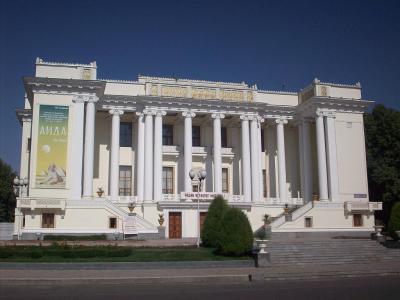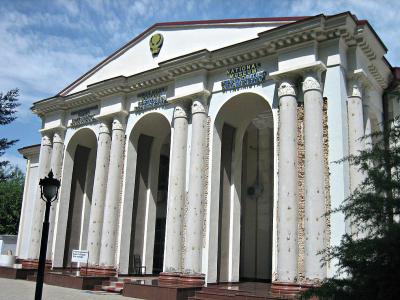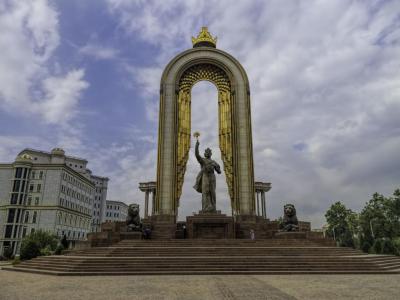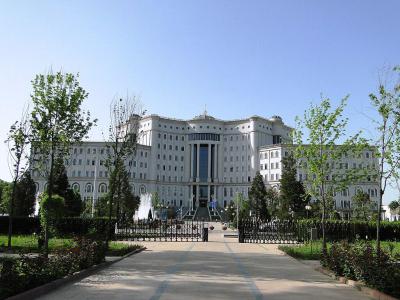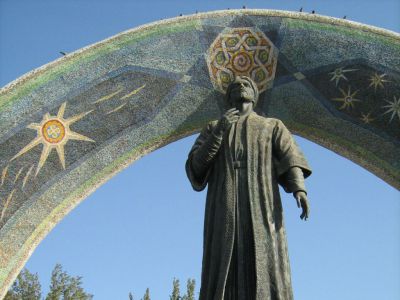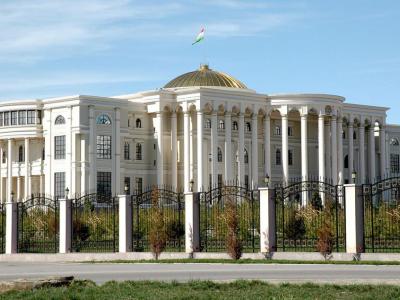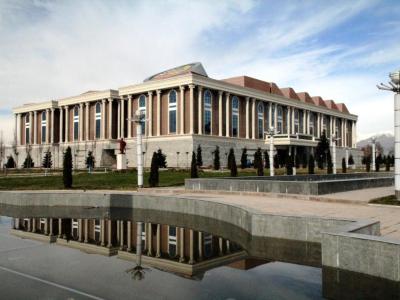Dushanbe Introduction Walking Tour I (Self Guided), Dushanbe
Relatively small in size, the city of Dushanbe, capital of Tajikistan, sits on the banks of the Varzob River and contains a number of notable sights, significant in terms of national history and culture. The most prominent local landmarks include Rudaki Park, bearing the name of the Tajik poetry classic; the Ismoili Somoni statue and gilded arch; the National Museum of Tajikistan; and more. To explore these and other attractions of Dushanbe, follow this orientation walk.
How it works: Download the app "GPSmyCity: Walks in 1K+ Cities" from Apple App Store or Google Play Store to your mobile phone or tablet. The app turns your mobile device into a personal tour guide and its built-in GPS navigation functions guide you from one tour stop to next. The app works offline, so no data plan is needed when traveling abroad.
Dushanbe Introduction Walking Tour I Map
Guide Name: Dushanbe Introduction Walking Tour I
Guide Location: Tajikistan » Dushanbe (See other walking tours in Dushanbe)
Guide Type: Self-guided Walking Tour (Sightseeing)
# of Attractions: 7
Tour Duration: 2 Hour(s)
Travel Distance: 5.1 Km or 3.2 Miles
Author: Maia
Sight(s) Featured in This Guide:
Guide Location: Tajikistan » Dushanbe (See other walking tours in Dushanbe)
Guide Type: Self-guided Walking Tour (Sightseeing)
# of Attractions: 7
Tour Duration: 2 Hour(s)
Travel Distance: 5.1 Km or 3.2 Miles
Author: Maia
Sight(s) Featured in This Guide:
- Dushanbe Opera and Ballet Theatre
- The National Museum of Antiquities
- Massive Statue of Somoni
- National Library of Tajikistan
- Statue of Tajik poet Rudaky
- Palace of Nations
- Tajikistan National Museum
1) Dushanbe Opera and Ballet Theatre (must see)
Ayni Opera and Ballet Theater was built in 1946 and is a classic example of Stalinist architecture. It hosts many performances and plays. The first Tajik ballet was performed here and the culture then started to grow and develop. Later, a new wave of Tajik artists became part the Theater and made it very popular. They participated in Russian and Western classic operas and visited Russia. Here you can attend beautiful performances with highly traditional Tajik features if you happen to watch a performance of foreign artists from any corner of the world.
2) The National Museum of Antiquities (must see)
The National Museum of Antiquities is famous for its amazing, large Buddha statue, which is almost 13 meters long. They say it is almost 1600 years old and is unique. Archaeologists found it in the city of Kurgan-Tyube and were amazed. You will see exhibitions from early ages, for example, a 6th-century scabbard and many other interesting, antique items that will help you build an image of early Tajikistan.
3) Massive Statue of Somoni (must see)
The Statue of Somoni was founded on September 9th, 1999 and is an attraction worth seeing. Tajik considers Somoni the father of modern Tajikistan. The statue is about 11 meters high. They say that the crown is made almost of pure gold and weighs about 10 kilos. This monument was built in honour of Ismail Somoni, who was a Tajik idol who even had currency named after him. The monument looks great and the huge golden ark above the statue of Somoni looks impressive.
4) National Library of Tajikistan
The National Library of Tajikistan is the primary library of the country, dedicated to preserving the cultural heritage of the Republic of Tajikistan. Originally established in 1933 and named after the Persian author Ferdowsi, the library underwent significant changes in 2012 with the opening of a new nine-story building and its renaming to the National Library of Tajikistan. This modern facility includes 15 reading halls and over 20 departments.
Access to the library is free for any Tajik citizen with a passport. The library's main focus is on works of national significance by Tajik people and internationally renowned works by Tajik authors. It also houses a digital collection known as the "Tajikistan National Electric Library," which is freely accessible to citizens within Tajikistan.
Access to the library is free for any Tajik citizen with a passport. The library's main focus is on works of national significance by Tajik people and internationally renowned works by Tajik authors. It also houses a digital collection known as the "Tajikistan National Electric Library," which is freely accessible to citizens within Tajikistan.
5) Statue of Tajik poet Rudaky (must see)
In 2007 the statue of Lenin was replaced by the statue of Tajik, the poet Rudaky. It was made to honour Rudaki's birthday in 1150 and to emphasize that he was the father of Tajik poetry. It is made of bronze by sculptor Vladimir Kozlov and is an exact copy of a monument previously established in Petersburg Smolny Palace. The statue is very beautiful and is surrounded by a colourful arc with paintings of stars and the sun.
6) Palace of Nations
Palace of Nations, also known as Kohi Millat, is the place where the President of Tajikistan, Emomali Rahmonov sometimes holds meetings or brings the summit. This place is very important for the country, because all the main events and meetings are held there and questions about future life, politics and economics are solved.
It was built in 2002 and is of a very beautiful, white colour; the building is very impressive and has a lot of arched windows. The roof is supported by massive columns. On top, there is a golden dome, which gives the building a rich, serious look. In the middle of the dome there is a flag of Tajikistan. Inside the building, everything is made stylishly and luxuriously and is a truly amazing place to see.
It was built in 2002 and is of a very beautiful, white colour; the building is very impressive and has a lot of arched windows. The roof is supported by massive columns. On top, there is a golden dome, which gives the building a rich, serious look. In the middle of the dome there is a flag of Tajikistan. Inside the building, everything is made stylishly and luxuriously and is a truly amazing place to see.
7) Tajikistan National Museum (must see)
This museum was opened in 1934. This museum is a unique place where you may find a lot of worthy information about the lifestyle in Tajikistan, the Socialist Realist style, Soviet-era literature and much more. You will learn how people lived many years ago, how Tajikistan was formed and who was behind it all. This museum has numerous exhibitions that are dedicated to the President - Emomali Rahmon. You will discover archaeological and ethnographic collections that will teach you more about Tajik history.
Walking Tours in Dushanbe, Tajikistan
Create Your Own Walk in Dushanbe
Creating your own self-guided walk in Dushanbe is easy and fun. Choose the city attractions that you want to see and a walk route map will be created just for you. You can even set your hotel as the start point of the walk.
Dushanbe Introduction Walking Tour II
Relatively small in size, the city of Dushanbe, capital of Tajikistan, sits on the banks of the Varzob River and contains a number of notable sights, significant in terms of national history and culture. Among the local landmarks featured here are the Presidential Palace, Haji Yakoub Mosque, Komsomolskoe Lake, and more. To explore these and other attractions of Dushanbe in more detail, follow this... view more
Tour Duration: 2 Hour(s)
Travel Distance: 4.4 Km or 2.7 Miles
Tour Duration: 2 Hour(s)
Travel Distance: 4.4 Km or 2.7 Miles
The Most Popular Cities
/ view all



